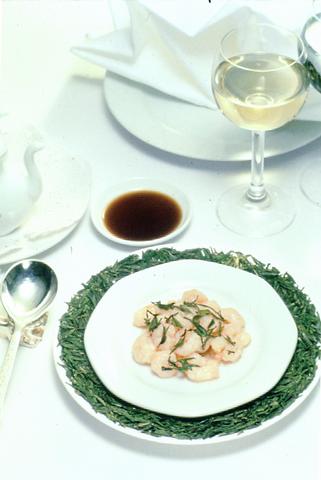For many in Taipei, Tien Hsiang Lo is a synonym for Hangchow cuisine, which, to many gourmands, is also a synonym for unique and exquisite delicacies. The original Tien Hsiang Lo restaurant in Hangchow dates back more than 100 years.
After the Chinese Civil War, in 1949, the main chefs of this famed restaurant fled to Hong Kong where they established the equally famous Hong Kong Tien Hsiang Lo. Thirteen years ago Stanley Yen (嚴長壽), president of Taipei's five-star Ritz Landis, dispatched chefs to Hong Kong with a mission to learn classic Hangchow cuisine from the chefs of the original Tien Hsiang Lo. Under a cooperative agreement, they returned to set up their own Tien Hsiang Lo in Taipei. The two restaurants are widely recognized as offering the best Hangchow cuisine in the world.

PHOTO: COURTESY OF RITZ LANDIS,TAIPEI
Hangchow cuisine can be summed up with the phrase "southern ingredients, northern style" (南菜北烹). This means that the varieties of fish, shrimp, and other crustaceans in Hangchow's much-celebrated historic West Lake are prepared in northern-style, sweet and sour-based flavors. Hangchow cuisine can be traced to 800 years ago, when the Sung dynasty moved its capital from the north to Hangchow, fleeing foreign invaders. The royal chefs, who had been accustomed to northern cuisine, had to make use of local materials. Hangchow style is, therefore, a kind of ancient imperial cuisine.
Sauted shrimp with long-ching tea leaves (龍井蝦仁) is a delightful representative Hangchow dish. Instead of using vegetables, the chefs saute the shrimp with freshly pickled long-ching tea leaves. The shrimp come out white and tender, while the tea leaves add an elegant presentation and delicate taste.
Madame Sung's fish soup (宋嫂魚湯) is a typical "southern ingredients, northern style" dish, according to Yang Kuang-tsung (楊光宗), sous chef of the hotel. This southern version of sour and spicy soup adds more vegetables and has abundant boneless fresh-water fish, mushrooms, egg yolk, bamboo shoots and a dash of Shaoshing wine.
One distinct plus about Tien Hsiang Lo is that dishes are presented in individual portions, which allows diners to sample a variety of flavors without having to order more food than one person can eat.
Autumn is also the best season to feast on giant fresh-water crabs, another Hangchow delicacy.

As I finally slid into the warm embrace of the hot, clifftop pool, it was a serene moment of reflection. The sound of the river reflected off the cave walls, the white of our camping lights reflected off the dark, shimmering surface of the water, and I reflected on how fortunate I was to be here. After all, the beautiful walk through narrow canyons that had brought us here had been inaccessible for five years — and will be again soon. The day had started at the Huisun Forest Area (惠蓀林場), at the end of Nantou County Route 80, north and east

Specialty sandwiches loaded with the contents of an entire charcuterie board, overflowing with sauces, creams and all manner of creative add-ons, is perhaps one of the biggest global food trends of this year. From London to New York, lines form down the block for mortadella, burrata, pistachio and more stuffed between slices of fresh sourdough, rye or focaccia. To try the trend in Taipei, Munchies Mafia is for sure the spot — could this be the best sandwich in town? Carlos from Spain and Sergio from Mexico opened this spot just seven months ago. The two met working in the

Exceptions to the rule are sometimes revealing. For a brief few years, there was an emerging ideological split between the Democratic Progressive Party (DPP) and Chinese Nationalist Party (KMT) that appeared to be pushing the DPP in a direction that would be considered more liberal, and the KMT more conservative. In the previous column, “The KMT-DPP’s bureaucrat-led developmental state” (Dec. 11, page 12), we examined how Taiwan’s democratic system developed, and how both the two main parties largely accepted a similar consensus on how Taiwan should be run domestically and did not split along the left-right lines more familiar in

This month the government ordered a one-year block of Xiaohongshu (小紅書) or Rednote, a Chinese social media platform with more than 3 million users in Taiwan. The government pointed to widespread fraud activity on the platform, along with cybersecurity failures. Officials said that they had reached out to the company and asked it to change. However, they received no response. The pro-China parties, the Chinese Nationalist Party (KMT) and Taiwan People’s Party (TPP), immediately swung into action, denouncing the ban as an attack on free speech. This “free speech” claim was then echoed by the People’s Republic of China (PRC),